
 |
|||||
|
|
|||||
|
|
|
|||||
|
|
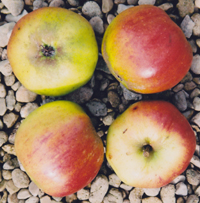 |
REINETTE D’ANGLETERRE English, French or Belgian, the only record in England is when it was received by the National Fruit Trials from Switzerland in 1947, though it was known in America in the 19th century as English Reinette, with a synonym of Reinette D’Angleterre. It is obviously an old apple, now forgotten in England. We received scions from the Belgian national collection in 2006. A late season apple, ripe at the end of October when it is powerfully rich, juicy and sweet, with a refreshing acidity. Excepting mild autumns, it will last well to the end of the year. A very good apple. Pollination Group 5 |
||
REINETTE DE THORN In 2016, Krystina Hill, Archivist of the Canterbury Apple Archive, at Canterbury, South Island, New Zealand, brought us some scions of this and other apples, held in South Island. Krystina is Polish and very attached to an old apple from her homeland – The Reinette de Thorn. She pointed out that it should correctly be called Reinette de Torun, Torun being the place of its origin in Poland and Thorn being the German name for this place after Poland was partitioned. The ‘Reinette De’ part seems to have come from the first recording in Belgium in 1854, as reported by Leroy in 1867 in his Dictionnaire de Pomologie. This apple now seems only to be found in New Zealand, and with us. Krystina had no record of how it found its way to New Zealand. She obtained it from a now-defunct nursery who probably obtained it from the University of Lincoln, NZ. Though Leroy described it very fully, we simply repeat Krystina’s words. “It is a superb, exquisitely rich tasting, apple, very drought resistant, hates being pruned but grows into a goblet shape naturally, and keeps very well. Dessert, but also superb in crumbles, pies etc. No need for added sugar. Fruits are variable, medium to very large - it seems like it should be a cooker due to its size but has an extremely fruity, juicy, rich apple taste. Soft-skin, softer-fleshed (ie. not mealy, not dense). Ripe, end March (in Southern Hemisphere). It's the star of my collection, taste wise, frankly. Reinette de Thorn seems unaware that blackspot and mildew exist.” Here it is ripe in October and will last to December. The apples are slightly ribbed, medium to large, pale green to yellow, with a warm blush and sometimes quite dark red streaks. It has a modest history in England. Scott included the name in his supplemental list in ‘The Orchardist’ in 1873. Pollination Group 3 |
||||
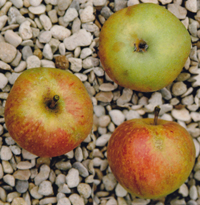 |
REINETTE
DES CARMES A French apple, dating from before 1667, with the
name alluding to the Carmelite order of monks, where the origin has been
assumed. Nevertheless, it is an apple with a long history in Britain and
since it appeared to have been lost here, as the only example at the National
Collection was judged to be the wrong apple, we sought out the genuine
example of this superior apple of antiquity. It still exists in European
collections, though our scionwood came from the Grove Collection in Tasmania.
It is one of those unfortunate apples which has been subject to name change,
and has attracted many synonyms, while also appearing as a synonym of
several other apples. It is hard to know when it first arrived in Britain
but it was in the collection of the London Horticultural Society before
1826. It was also described in Scott’s ‘The Orchardist’
of 1872. It has not had any reliable sightings since. A medium sized apple,
ripe quite late in the year (as with many other French apples) in November,
and lasting until February. It is slightly conical, with obscure ribs,
red blushed and streaked over a green skin, turning yellow, often thinly
russeted, and with prominent pale spots over the red. The flesh is firm,
not so juicy and a little dense, but sweet, very rich and aromatic. Pollination
Group 6 |
|||
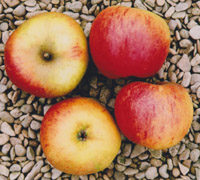 |
REINETTE
DORÉE A very old apple, first recorded in the List of
La Quintinye in 1680 and first noted in England when in the collection
of the London Horticultural Society in 1842. Though it might seem to be
just a French naming of Golden Reinette, this apple is different. It was
well described by Scott and Hogg. It has not been known in England after
the 19th century though still exists in France and Belgium. We received
scionwood from Tasmania in 2005. It is a very good apple indeed, bright
and colourful. Ripe in mid October, the flesh is crisp and melting, juicy
to the point of wetness, sweet and gently acid. The flavour is not strong
but is very refreshing. It retains its juiciness and flavour to the year
end. Pollination Group 4 |
|||
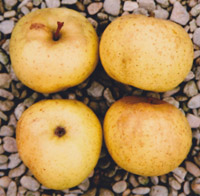 |
REINETTE
DOUCE The only substantial history of this apple comes from Leroy
in his ‘Dictionnaire de Pomologie’ of 1873. He records that
it dated from before 1765 when it was noted in Normandy and seems to have
been used there extensively as a cider sweet. Leroy’s description
precisely matches the apple we obtained from the Grove Collection, in
Tasmania, in 2005, the only source to be found, worldwide. A small to
medium sized flattened round apple of amber yellow, with russet flecks,
extremely sweet, when ripe in October and entirely without acid. The flavour
is quite honeyed, not purely sweet, and the apple is enjoyable to eat
raw. It will last for a month or two before shrinking. Pollination Group
5 |
|||
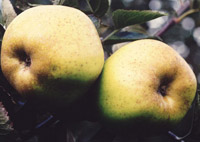 |
REINETTE
DU CANADA A dual purpose apple, which despite its name would
seem to be European. First mentioned in Britain in 1771, and grown all
over Europe and North America by the early 19th century. Greenish-gold
apples with an orange flush and russeting; the flesh is sweet and fruity,
when eaten raw and keeps its shape when cooked, with a rich flavour. Strong-growing
trees, which have attractive blossom and crop reliably. The fruit is ready
to pick in mid October, and stores well until March. The apples can be
really quite large if grown in restricted forms. T. Pollination Group
4 |
|||
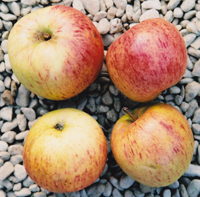 |
REINETTE
FRANCHE Leroy in his ‘Dictionnaire de Pomologie’
of 1873 suggests this apple might date back to the first part of the 16th
century, but it must be uncertain. He also delineates 4 different shapes,
so there might have been different versions in the accounts of old literature.
One of them was in the London Horticultural Society in 1826 and later
described by Lindley, Scott and Hogg. Theirs seems to be the same as the
one we received from the French National Collection, in 2006. A very attractive
apple, delicately streaked with pink and red and ripe in mid September,
with us. The fine flesh is crunchy and crisp, quite juicy, sweet and rich,
with a subtle and very pleasing scented flavour. In our milder autumns
it has not lasted as well as it might in former times, and loses flavour
in November. A very good apple. Pollination Group 5 |
|||
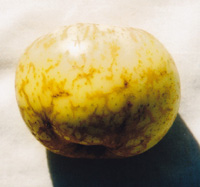 |
REINETTE
MARBRÉE The ‘Marbled Reinette’ is named from
the pretty veining of russet that covers the apple. It was first recorded
in 1760 by the Dutch pomologist, Knoop, and was believed to be Dutch,
but its history has been confused, having also been assumed the same as
several other apples including Embroidered Pippin and Drap D’Or.
It was possibly in the 1826 collection of the LHS under one or more synonyms.
A late dessert apple, rounded and of dull green, becoming yellow, sometimes
flushed with a little red and covered with broken lines and dots of russet.
The flesh is firm, sweet, not particularly acid, fragrant and rich. Ripe
in October, it will store into the New Year and has also been used for
cooking and juicing. Pollination Group 4 |
|||
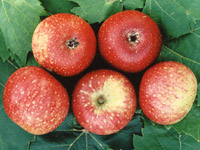 |
REINETTE
ROUGE ÉTOILÉE Originally Belgian or Dutch, and
first described in 1830. A highly coloured, very showy, late dessert apple,
with a deep red skin and star-shaped russet freckles - hence the name
‘Étoilée’, or ‘Starred’. The fruit
has a delicious raspberry flavour, with juicy, crisp, white flesh which
is often streaked with carmine and stained pink beneath the skin. It will
store until January. Heavy crops on upright, part tip bearing trees with
pretty blossom. Pollination Group 5 |
|||
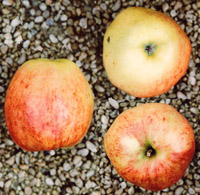 |
RENAISSANCE An old, now unknown variety brought to us by Geoff Goodchild of Hughenden Valley, Buckinghamshire, a ‘countryman’ who knows his apples. For many years, a collector of interesting old fruits, he had this from Chalet Nursery at Speen, Buckinghamshire, when the nursery disappeared under housing in the 1960s and the origin and variety name were never known by Mr Goodchild. Aware of it being such a superior apple, he sought the name but without success, and we have compared it with thousands, without a match. Hence, we have renamed it ‘Renaissance’ in the sense of ‘reborn’. It is medium sized, round and conical to oblong, with skin of pale yellow, when fully ripe, with a pale, carmine to pink flush and a few thin streaks of darker red. The flesh is a near perfect combination of sweetness, crispness, juiciness, acidity and flavour. The apples are so full of juice that it oozes out, when cut. Ripe in October, it will last in good condition for a month or two. We are very grateful to Geoff Goodchild for this apple and other contributions to our work. Pollination Group 4 | |||
|
||||